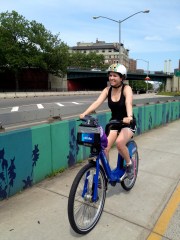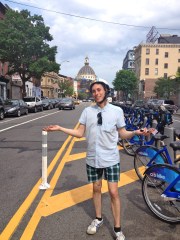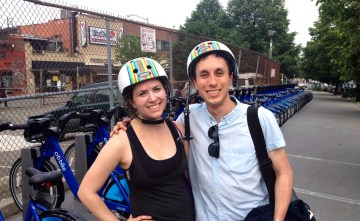
New York City is about to get a lot of blue mixed in with its yellow cabs. This weekend, the city officially unchained its royal blue-colored Citi Bike program, opening the bike-share service to daily and weekly riders. With more than 6,000 bikes and 330 stations scattered throughout Manhattan and into Brooklyn, New York‘s long-anticipated program joins the worldwide bike-sharing craze, modeling itself after other cities with similar self-service stations from Barcelona to Minneapolis.
To get a feel for the new program, we decided to take the bikes for a spin throughout the city. Twelve miles, 11 (mandatory) stops and six hours later, here’s how we fared on two wheels:
Neither Alexandra, a TIME.com health writer, nor Nick, TIME.com’s homepage editor, had ever biked in Manhattan–and that was obvious. At least initially. Getting the bike was simple, just a swipe of your credit card and you’re set for the day. Zipping in and out of cabs, buses and the more than occasional horse-drawn carriage? Not so simple. Thankfully, New York City has implemented bike lanes on several major streets — more than 350 miles of bike lanes in the past few years — so biking newbies and the more aggressive messenger riders can share the road.
(MORE: We Tried This: The First Underwater Cycling Class In The U.S.)
The bikes were comfortable — more so for Alexandra — and easily adjustable (we’re both not very tall). Although the bike’s body appears clunky — it’s a hulking 45-lb. mass of metal, according to official documentation — after some initial teeter-tottering, we got the hang of it.
The initial fear of navigating the congested city streets — knowing full well every inch of asphalt is packed with irreverent pedestrians and aggressive cab drivers — quickly evaporated as what we know to be a 10-minute walk turned into a zippy minute-long ride into the center of New York City’s action. Citi Bike seems infinitely useful for those dastardly crosstown trips, where public transportation is either slow or non-existent, and vehicle traffic is often at a chokehold.
We got separated for a good 20 minutes when a cab cut off Nick, and in classic New York fashion, a parade down Madison Avenue further exacerbated the distance between us. But considering our journey took us from Manhattan’s Upper West Side, 50 blocks south through Union Square, Madison Square Park, the Lower East Side and Chinatown, and later over the Manhattan Bridge into Brooklyn, only one major public interference is pretty good for a Sunday afternoon.
There were definitely a few lessons learned. First, the bikes are not meant for leisurely rides throughout the city, and certainly not the bike odyssey we attempted. Even though riders pay $10 to use the bike for the full day, you still need to check the bike into a station at every half hour (annual users get 45 minutes between rides). That’s so bikers don’t check out a bike and hoard it all day long (Alexandra would probably do that). The intended use is quick commuting. A rider should feasibly be able to get themselves to work or a rendezvous with friends in under 30 minutes. You get charged an extra $4 each time you exceed the half hour check-in time.
On more than one occasion, Nick’s timer went off at 27 minutes and we frantically pedaled to the nearest station. When the stars align, there’s another station just around the block. But with our luck, we often came across a couple stations already full with bikes, with just one opening, or a bum machine that wouldn’t accept the bike. We wouldn’t be surprised if the time limit was one of the first modifications made to the system.
There are other glitches to be worked out too. Since the kiosks feature tried-and-true (and much-embattled) software from Montreal-based PBSC Urban Solutions — the same system powering bike-share networks in Chicago and Chattanooga, Tenn. (and a successor to the fruitful programs in Boston, London and Washington, D.C.) — we’d anticipated smooth sailing. Suffice it to say that an afternoon of swiping credit cards, punching in unlock codes multiple times and zero success at dialing the Citi Bike helpline ensued. One system that was out of power led to a much-delayed start, and a broken dock led to us being erroneously socked with an overtime fee.
(MORE: We Tried This: With MovNat, Play Like You’re a Kid Again)
But besides a few glitches — some our own rookie mistakes — one of the greatest parts of the experience was that New Yorkers actually stopped to chat with us about the program. Everyone was curious–the mom with the stroller, the construction worker on his break, the elderly couple.
As of Monday evening, the program had sold 29,156 total annual memberships and since the launch, there have been over 75,707 rides, with the average cyclist riding for 20 min., 20 sec. on Sunday. “With 75,000 trips in just one week, Citi Bike is New York’s new summer blockbuster,” says department of transportation commissioner Janette Sadik-Khan. “It’s like a cross between social media and transportation — these bikes are three-speed conversation pieces.”
Minneapolis pioneered the first bike-sharing program in a major U.S. city. Since Nice Ride launched in 2010, the program has nearly tripled to 170 stations. “It definitely takes a while for people to figure it out, but the public acceptance of the idea came pretty quick,” says Bill Dossett, executive director of Nice Ride. “People recognize this was a smart alternative.”
(MORE: We Tried This: “Pop-Up” Cardio)
And it’s fun too, especially for well-worn pedestrians long forced to dodge eco-conscious commuters peddling their fixies and messengers powering their steely mountain bikes. There was something magical about being aboard a bicycle; we were afforded an entirely different view of the city. Surely this is something New York’s devoted cyclists feel on a daily basis, but spreading the feeling to those usually confined to foot? Now that’s a fast track to greater enjoyment of the city’s streets.




